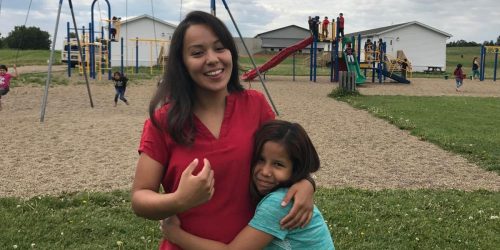Burman University Student Has a Life-Changing Experience
There is so much they [these children] can do. It only takes someone to see that potential in them and to give them an opportunity to grow.

While I have lived in Edmonton, Alberta, for most of my 22 years, I never had much interaction with First Nation groups. I didn't even know that First Nations reserves existed or that First Nations people face difficult situations in Canada. I had also never heard of Mamawi Atosketan Native School (MANS), even though it is located just an hour's drive from Edmonton.
During my junior year at Burman University, I was sent to MANS for my first practicum. I didn't know what to expect from the third-grade students, but I made big plans. I thought, They will learn so much from me, and they will love me!
For the first two weeks, everything went according to plan. Then the class read Buddy, the First Seeing Eye Dog by Eva Moore, a book about a dog who eventually dies of old age. As we discussed the story, a little girl raised her hand.
"I once had a puppy die," she said.
I looked at her and said, "I'm so sorry. I can't imagine how it must feel to have a pet die."
A boy raised his hand. "Recently, I had a cousin die," he said.
Then another boy raised his hand. "My kokom died," he said, using the word for "grandmother" in his native Cree language.
Suddenly, all the students were sharing their experiences about parents, siblings, cousins, and uncles and aunts who had died recently in accidents, shootings, drug overdoses, and house fires. As I listened to the children talk about their personal encounters with death, it struck me that my purpose at the school was not just to teach.
The children are living through things that I have never experienced. So many things are going on at home, including poverty, family trouble, and alcohol and drug abuse. Then after dealing with these difficulties at home, the children come to school and must focus on learning the alphabet and math.
It was at that exact moment that I realized my purpose was to serve the children. As I worked at the school, I got to see where my children live. I saw their rundown homes and lack of paved roads or sidewalks. Their reserve is like a tiny developing country in the middle of Alberta, and that blew my mind.
When my practicum ended, I cried. I couldn't believe that, before starting the practicum, I had thought I had so much to offer. In the end, it was the children who offered the most. They have so much love, and there is so much they can do. It only takes someone to see that potential and to give them an opportunity to grow.
The biggest thing I learned at the school is that the children watch everything you say and do. I realized that they needed to see Jesus in me. It doesn't matter if they remember the geometric shapes that we studied. All that matters to me is that they remember Jesus and His love. I didn't want to leave. If I could stay at the school, I would stay forever.
By Angelica Cornejo, as told to Andrew McChesney, Adventist Mission
